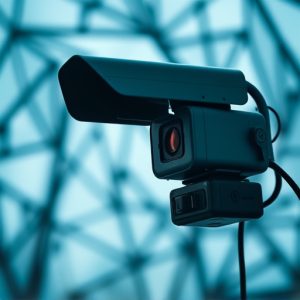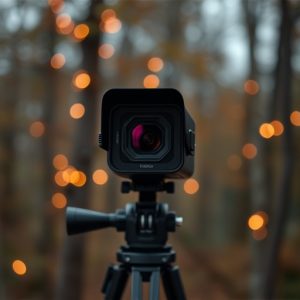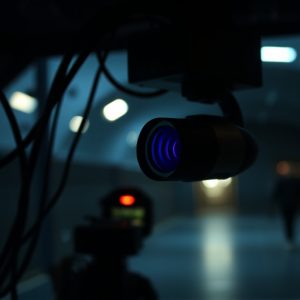Unveiling Spy Cameras: Light Reflection for Efficient Detection
Motion-activated spy cameras, powered by advanced sensors and efficient battery systems, offer enhan…….
Motion-activated spy cameras, powered by advanced sensors and efficient battery systems, offer enhanced security. They detect movement using infrared or PIR technology and capture data discreetly. Light reflection detection, a cutting-edge method, identifies hidden cameras by analyzing irregular light patterns. While effective in homes and offices, this technique faces challenges from false positives and limited battery life. To improve detection, disrupt consistent light patterns, maintain lighting, stay updated on spy camera tech, and calibrate motion-activated systems for better accuracy.
Uncover the insidious world of motion-activated spy cameras and their silent surveillance tactics. This article delves into the advanced science behind light reflection detection, a cutting-edge technique for identifying these hidden devices. By understanding how these cameras operate—typically relying on motion triggers and battery life management—we explore the benefits of using light reflection analysis. We also dissect challenges, limitations, and best practices to enhance detection efficiency, ensuring you’re equipped with knowledge to counter this modern threat.
- Understanding Motion-Activated Spy Cameras and Their Operation
- The Science Behind Light Reflection Detection
- Advantages of Using Light Reflection for Spy Camera Identification
- Challenges and Limitations of the Technique
- Best Practices and Countermeasures to Enhance Detection Efficiency
Understanding Motion-Activated Spy Cameras and Their Operation
Motion-activated spy cameras are a popular choice for home and office security, designed to capture activity only when movement is detected. These devices use advanced sensors to trigger their recording mechanisms, ensuring that every captured moment is meaningful and relevant. The operation of such cameras revolves around two key components: sensitive motion sensors and efficient power management, particularly in terms of battery life.
When a potential intruder enters the camera’s field of view, its motion sensor picks up on the change in surroundings, prompting the camera to activate. High-quality motion-activated spy cameras employ advanced technologies like infrared or passive infrared (PIR) sensors, which can accurately distinguish between human movement and other environmental changes. Once triggered, these cameras capture video or still images and store them for later review, often with a focus on enhancing low-light conditions for clearer visuals. Efficient battery life is achieved through various power-saving modes, ensuring the camera remains operational for extended periods without frequent replacements.
The Science Behind Light Reflection Detection
The Science Behind Light Reflection Detection is a fascinating interplay of optics and technology. This technique leverages the principle that light, when reflected, can reveal hidden devices like motion-activated spy cameras. When a camera’s infrared LED flashes to capture motion, it emits light at specific wavelengths. These wavelengths, when reflected off surfaces, create a unique pattern that can be detected by specialized sensors.
By analyzing these reflected light patterns, the system can identify irregular reflections indicative of a hidden camera’s presence. This is particularly useful in scenarios where spy cameras are cleverly disguised and powered by batteries with limited lifespans, such as those found in motion-activated devices. Understanding this reflection process is crucial for developing effective countermeasures against covert surveillance, especially considering the ongoing challenge posed by ever-improving spy camera technology and their corresponding battery life management.
Advantages of Using Light Reflection for Spy Camera Identification
The light reflection technique for spy camera detection offers several advantages over other methods, especially in enhancing security measures. One of its key benefits is the ability to identify hidden cameras discreetly and efficiently. By utilizing specific wavelengths of light, this method can detect even the smallest or most advanced spy cameras without causing any visible or perceptible disturbance. This is particularly useful in environments where discretion is paramount, such as in homes, offices, or public spaces where motion-activated spy cameras with long battery life might be strategically placed.
Furthermore, light reflection technology provides a non-invasive approach to surveillance. Unlike physical searches or other detection methods that could alter the setup, this technique leverages natural light or specialized lighting to reveal hidden camera lenses. This not only ensures minimal interference but also prolongs the lifespan of equipment as it avoids any potential damage during the detection process. Additionally, with motion activation and battery life considerations, spy cameras equipped with these features can be more easily uncovered, making it a game-changer in maintaining privacy and security.
Challenges and Limitations of the Technique
While the motion-activated spy camera detection technique using light reflection offers a promising approach to identifying hidden cameras, it’s not without its challenges and limitations. One significant hurdle is the potential for false positives, where everyday objects or natural light patterns can trigger the sensor, leading to unnecessary alerts and possible privacy invasions in innocuous environments.
Additionally, factors like camera quality, angle of incidence, and ambient lighting conditions can impact the accuracy of the technique. For instance, high-resolution cameras with advanced sensors might evade detection due to their subtle light output or unique reflection patterns. Furthermore, limited battery life in motion-activated devices poses a challenge, as continuous monitoring becomes less feasible, especially in large areas or during extended periods.
Best Practices and Countermeasures to Enhance Detection Efficiency
To enhance detection efficiency of spy cameras, especially those employing motion-activated features and long battery life, several best practices and countermeasures can be employed. One effective method is to utilize advanced light reflection techniques, such as irregular surface placements or reflective materials in areas where surveillance is suspected. This disrupts the consistent light patterns that motion sensors rely on, reducing false positives. Additionally, regular maintenance of lighting fixtures and outdoor spaces ensures optimal illumination, aiding in capturing any unusual reflections or distortions that might indicate hidden cameras.
Moreover, staying updated with the latest spy camera detection technologies is vital. This includes keeping abreast of advancements in image processing algorithms capable of identifying subtle anomalies in light reflections. Furthermore, combining visual inspections with thermal imaging or infrared sensors can prove beneficial, as these tools excel at detecting heat signatures commonly associated with electronic devices like hidden cameras. Regularly testing and calibrating motion-activated systems with various triggers and delays can also significantly improve detection accuracy, particularly when dealing with low-quality or covert spy cameras.
The motion-activated spy camera, with its advanced light reflection detection technology, offers a promising approach to identifying hidden surveillance devices. By leveraging the science of light and its behavior upon impact with various surfaces, this technique provides an effective way to combat the growing prevalence of such cameras. While challenges exist, particularly regarding battery life and environmental factors, continuous advancements in sensor technology and algorithms are enhancing detection efficiency. Embracing best practices and staying informed about countermeasures ensures a robust defense against these covert recorders, promoting privacy and security in our digital age.


